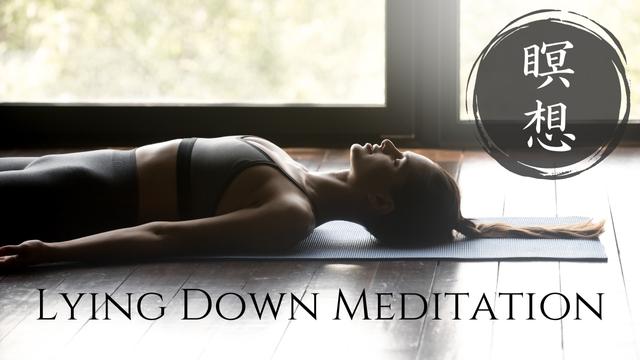
What kind of image do you have for meditation?
Nowadays, "Mindfulness" and "Vipassana Meditation" are being adopted as a part of the in-house program among large companies such as Big Tech, and they are becoming more familiar, isn't it?
More than 10 years ago, this is the image I had when I first tried to meditate."Eh? Meditation is sitting in zen style (zazen) and making my heart empty, right?" Perhaps, some of you have the same image.
This image is the biggest factor I have long been thought that "something difficult to meditate."
Reading this article will completely overturn that image.
You'll be fine. You don't have to do zazen. You can easily meditate while lying down.
It doesn't mean that while sleeping. Which means "Lying Down Meditation." It's a meditation that you can relax while lying on the bed without having zazen.
And this meditation is not a meditation pretend to be mindfulness celebrities.
The goal is to enter a deep meditation state where you can feel the changes in brain waves.
If you can't understand it with a book on the market, or if you can't put it into practice due to the thin content on the surface, please refer to this article and try lying meditation.
Taro
Let me introduce myself a little.
Originally I worked as a massage therapist, and I was studying various massage techniques and healing methods. At that time, I received a therapy called Craniosacral Biodynamics, and realized that the feeling at that time was almost the same as the deep meditation state, and decided to try meditation by myself.
"Mindfulness meditation" and "Vipassana meditation" have been dealt with among Bit Tech, so I bought some books on the market and read various blogs to study. However, although I can understand the general theory by reading books and blogs, it does not come to my mind.
It is written only abstract things and never said the specific methods to meditate. In many cases, there was no mention of what it would be like to enter a meditative state. Perhaps the person who is writing has never entered a state of deep meditation, so he may not know the specific method or feeling. This also makes meditation difficult and difficult to handle.
In fact, some of you may have bought a meditation book but it didn't work. If you feel "Hmm? Is this meditation I'm doing? "
It's NOT.
However, it is still early to give up.
In this article, I will explain "How do I get into the deep meditation state in the second challenge of meditation, which is an easy way to meditate while lying down" as specifically as possible, so that anyone can easily understand it. If you want to give up, read this article first and make a mistake.
I will tell you my actual experience about how I felt when I get into the deep meditation and what happened after that. So, please refer to it. The mystical experience after entering a deep meditation is totally up to you.
What is meditation and deep meditative state

"Meditation is sitting in zazen and making my heart empty, right?"
I completely thought so at first.
I was firmly convinced that meditation was to form zazen and try to get enlightened by emptying my mind. Of course, there are various types of meditation, and some focus on nothing.
"Mindfulness meditation" and "Vipassana meditation" that have been talked about these days are also called "Awareness meditation." It is a meditation that accepts the feelings as they are and feels like just observing and subconscious one's mind.
The meditation method I will tell you today is more like this "Awareness meditation."
The "Mindfulness meditation" adopted by Big tech is said to be good for the act of meditation itself, or "If you mindful and refresh your mind, your work will be done!" I think that it is a "meditation = cool" way of thinking.
What I emphasize here is not "the act of meditating" but "get into deep meditation state."
It doesn't matter which one is right, but I think there are many people who think meditation = cool and have never actually get into deep meditation are just somehow meditating and calming down and being satisfied.
It may be a little difficult, but I will explain what is "meditation state" I'm saying.
The meditative state is sometimes referred to as an altered state of consciousness, a hypnagogia, a half-awake, a drowsy state, a REM sleep state, etc... and it is considered that the brain environment is almost the same in these states.
Let me explain easily by brain wave.
| δ: Delta wave | 1-4Hz | Deep sleep |
| θ: Theta wave | 4-8Hz | Meditation state / Hypnagogia ← Aim for |
| α: Alpha wave | 8-13Hz | Relaxed ← Pretend to be meditation |
| β: Beta wave | 12-24Hz | During normal activity |
| γ: Gamma wave | 24-70Hz | Brain moves high speed |
δ: Delta wave 1-4Hz
Delta wave is the slowest state of brain activity.
It refers to a state of deep sleep, so-called Non-REM sleep.
It has the most ability to rest and recover the body, which is prominent in newborns and young children, but decreases with age.
Therefore, if this delta wave state can be stably created during sleep, it can have a positive effect on good sleep and improvement of the immune system, learning ability, and activity ability.
θ: Theta wave 4-8Hz
This is the state of brain waves that you should aim for in meditation.
Theta was appears during deep meditation, altered state of consciousness, drowsiness, hypnagogia, and REM sleep.
It refers to the state in which the body is asleep but the brain is awake.
Many theta wave appears even when dreaming, but by consciously creating this state by meditation, the senses are sharpened and the imagination and intuition are dramatically enhanced.
I'm not sure about accessing the subconscious, but I'm sure it's a mysterious sensation.
I feel that if we increase the number of theta waves in meditation, we will inevitably be able to create good delta waves. It's my personal opinion.
By the way, if you train in various ways during this meditation state, or if you repeat the challenge, you will be able to raise and awaken the kundalini, have a lucid dream, and be able to out-of-body.
I sometimes have lucid dreams, but I haven't succeeded in out-of-body yet.
I don't recommend Kundalini Rise & Awakening because it's very enthusiastic, but if you're interested after reading this article, take a sneak peek of my next article about Kundalini Awaking.
α: Alpha wave 8-13Hz
Alpha wave is a state that your body and mind are relaxed.
This brain wave is often present when you are lying on the sofa or bed and relaxing, taking a bath or receiving a pleasant massage.
Somehow you are meditating, or trying like "Simple meditation method that can be done in 5 minutes!," I think that the brain wave is in alpha.
You can still relax, so I think it's good, but just keep in mind that the true state of meditation isn't here.
In my case, it takes at least 10 minutes to get into theta wave meditation.
It can take up to 30 minutes or more for a long time when I'm tired or in bad condition and sometime I give up without going into meditation.
A meditation master may be able to get in in a blink of an eye, but like "in at least 3 or 5 minutes!" I don't think you have to trust it so much.
β: Beta wave 12-24Hz
The brain wave during normal activity is in this beta wave state.
Most of the activities you do while you are at work, studying, or waking up should be understood as the state of this brain wave.
The frequency is high and there is a feeling of high tension, so if this state continues for too long, it will lead to excessive anxiety and stress will build up.
Therefore, in order to rest the brain, it is necessary to secure as much time as possible to become alpha wave, theta wave, and delta wave.
By the way, "enter the zone" that you often hear in sports is that by bringing the brain waves closer to the alpha wave when you are active in beta wave, the extra tension is released and the senses are sharpened, it is a phenomenon that you can see a ball stops and you can see the other party looks like slow motion.
Training to control this brain wave has also been increasing recently.
γ: Gamma wave 24-70Hz
Gamma wave is often unclear and was previously considered part of beta wave.
Gamma wave can be seen, especially when the brain is moving at high frequencies during normal activity.
Brain wave is in theta wave during normal deep meditation, but it seems that the brain wave may show in gamma during REM sleep and during meditation performed by high-ranking monks.
Is brain in full rotation even though the body is resting?
I don't understand this area, yet.
-----
To recap, the state we should aim for in this meditation is theta wave, which is between the alpha wave during relaxation and the delta wave during deep sleep. Only after grasping this feeling, we can say that we have got into a state of meditation.
Can I meditate while lying down?
Of course you can. That's why I'm writing this.
At first, I thought that meditation is the process of zazen and making my heart empty. I think that many of you have taken meditation in that way.
The bottom line is that any posture is fine as long as you can get into the meditative state. You can lay down, you can sit, and the master is meditating while walking.
Actually, I also tried meditation while lying down without zazen from the first time, and I was able to easily get into a deep meditation state with the second try. The reason I tried to meditate while lying down without zazen from the beginning was because I originally had a hernia and my lower back was bad.
However, when I read a meditation book, it says that it is important to sit down and raise the pelvis. This is absolutely impossible for people who have bad lower back. In the end, they say that the best recommended posture is "Kekkafuza (Full Lotus Position)," which is absolutely impossible for people with hard hip joints.
At this point, my motivation for meditation was perfectly zero.
I was frustrated and searched for various ways and found that there was a meditation method that I could do while lying down. And I tried various breathing methods while lying down, it was surprisingly easy success for the second try. It's like that. I want to get the time back I have been hesitated.
What I referred to was the posture of lying face up in Shaversana or Yoga Nidra.
The method of meditation is to follow the method of Samatha meditation and Vipassana meditation, just concentrate on breathing, accept the thoughts and emotions that have come up as they are, and concentrate on breathing to enter the meditation state. I will explain the details later.
Once you know what meditative state feels like, you can do it sideways or sit down. (Even now, when I'm sitting, my body hurts and I can't concentrate, so when I sit down and meditate, I'll cross-legged and put my back on the wall.)
The point is that you can meditate better if you are in the most relaxed state. If you do it in an unreasonable posture, you will not be able to concentrate.
How to meditate while lying down - How I got into deep meditation in my second challenge
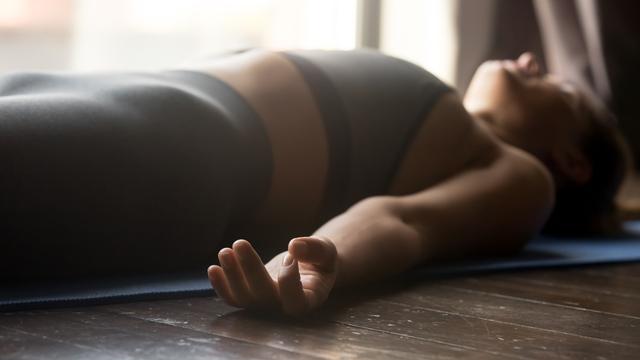
From here, I finally start the practice method. I'm sorry to have kept you waiting, maybe I've kept you waiting too long.
This lying down meditation is a completely original way of arranging the various meditation methods that I actually practice and getting into a deep meditation state with surprising ease.
The purpose is to get into the deep meditation state = brain wave into theta wave state, so I apologize because the situation is a little different from the relaxation method and stress relieving method.
However, I don't see many meditation books or web sites that explain how to get into the meditation state in detail so far, so please refer to it.
At first, I think it's okay to imitate fully, but if it doesn't fit, it's best to arrange it in your own way and work not too hard and happily.
1. Release physical tension with Stretching, Yoga, Massage
Actually, this is a very important factor.
In order to get into a state of deep meditation, the tension of the whole body needs to be released.
Therefore, it is important to take stretching, yoga, and massage before meditation to firmly remove muscle tension and stiffness and relax the whole body.
If you do not take this step and neglect it, you may not be able to get into the meditation state easily, or even if you do, the stiffness of your muscles will interfere and you will not be able to meditate well.
Originally, the various poses called asanas performed in yoga are also warm-ups for the ultimate goal of good meditation, maybe.
I don't think beginners need to get full-fledged yoga or massage from the beginning, but at least you should do some simple stretching and make some of your concerns easier.
2. Prepare an environment for meditation
Next, let's prepare an environment for meditation.
This meditation method of mine recommends with lying down, so it's best to do it on the bed you're always sleeping on.
You can use pillow as well, but I want to keep them straight from the waist to the head, so if the pillow is too high, remove it.
Also, it is better be alone in the room as much as possible.
It's not impossible to have a partner, but when they are snored or sleep-talked on the way, you can solve meditation at once. Well, as much as possible.
Also, let's finish the toilet in advance. If you have a urge to urinate during meditation, you have no choice but to stop.
Others are your favorite, but you can also play music such as healing music, or you can burn your favorite aroma.
You can find a lot of music on YouTube or Spotify by searching for "meditation music."
Music, scent, and everything is all right if you feel comfortable with it.
3. Lying down with Shavasana pose
If you come to this point, you can say that the preparations are complete.
Get ready to lie on your back and start meditation.
A pose called Shaversana is recommended for beginners .
Well, it's an ordinary supine posture.
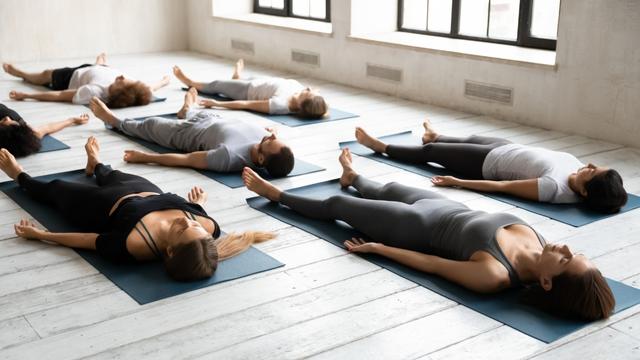
Keep your legs slightly open, your arms slightly away from your body, and your palms facing up.
The palm is better upwards, but if you feel awkward, it doesn't matter whether it's sideways or down.
The grip is neither stone nor paper, and just like natural.
It is said that half-eyed is good, but it's okay to close it at all.
Close your eyes in a natural way without putting too much effort.
If possible, you don't want to put extra pressure on your body at first, so it's best to go without a blanket.
Yea, the initial posture is perfect like this.
As I will explain later, you tend to focus on Tanden where is at the bottom of your stomach, so it's okay to gently put your left or right hand, or both hands, just below your navel.
I think that the meaning of this area will become clear as you repeat meditation several times.
If you feel itchy on your body or face at this point, scratch it until you feel refreshed!
You better move on to meditation in a stress-free state as much as possible.
4. Take 3 deep breath to relax your whole body
It's finally time to start meditation.
First, take a deep breath 3 times to relax your whole body.
All future breath including this deep breath will be " nasal breath."
Do not breathe through the mouth at all.
It's all "nasal breathing", inhaling through the nose and exhaling through the nose.
There are various reasons, so shut up and just breathe through your nose.
First, take a deep breath through your nose.
If 10 is the limit, let's inhale a lot around 8. It's a bit tough to inhale up to 10, so it's okay to inhale a lot and stop naturally.
The image at this time is that inhales air to fill the lungs (chest) and inflates them.
After inhaling a lot of air into the lungs up to about 8, stop for about 3 seconds.
You can count it as "one, two. three" in your heart.
This time, I will slowly exhale the air from my nose, but at this time, I am conscious of slowly dropping the air accumulated in my lungs into "Dantian," and completely exhale the air. want.
Yes it was! It is "Dantian." This is a super important spot.

It is also called Dantian breathing and it is very important to breathe with this Dantian in mind.
This breathing method is also a combination of chest breathing and Dantian breathing.
I will explain it again.
I breathe in through my nose and exhale through my nose, but my consciousness is that the air that fills my lungs is slowly dropped into Dantian, and all the air is exhaled.
If you can successfully drop the air into Dantian, you will feel that your body is losing strength.
When you send air to Dantian, you may have an image that your whole body loses power, or you can sing it in your heart like "Let's lose power."
It's easy to understand to explain in second.
It's like inhaling a lot in 4 seconds, stopping for 3 seconds, and slowly exhaling for about 8 seconds, but you don't have to worry too much about the number of seconds.
It's OK as if you inhale a lot, stop for a moment, and exhale slowly.
There is a famous breathing method for a good night's sleep called "4-7-8 breathing method," but in my sense, holding my breath for 7 seconds feels a bit baffling, so "4-3-8" I think it's just right.
Well, you can arrange it as you like.
This is one deep breath by here.
You repeat this breath 3 times, but you can do it 4 or 5 times until you feel that your whole body has lost your strength and that your mind has calmed down.
I think that if you do it 5 times, you will be relaxed enough.
step
1Take a deep breath through your nose for 4 seconds (about 8/10) and fill your chest.
step
2Hold your breath for 3 seconds.
step
3Slowly exhale completely from your nose for about 8 seconds, as if you were dropping the accumulated air into Tanda.
Point
Let's remember "4-3-8 breathing"
5. Release tension in each part of the body by breathing (open capillaries)
At this point, I think your heart is calm and your whole body is relaxed.
From here, we will focus more on each part of the body and completely release the tension by breathing.
There was a breathing method that I referred to, but I forgot the name.
It's a breathing method that I arranged it, but when I looked it up recently, it seems that there is a similar breathing method in "Yoga Nidra," which is said to be sleeping yoga.
I haven't actually done it, so I'm not sure about the details, but I think you can find a breathing method with a similar technique if you search all over the world, so it seems that it is not the wrong method.
First, it's the same as earlier that taking a deep breath until you inhale a lot from your nose and inflate your lungs.
Inhale to about 8/10 and stop for about 3 seconds, and this time sending air to each part instead of Dantian.
For example, when you are conscious of your left foot, it feels like the air stored in your lungs is slowly dropped through your left leg toward your left foot.
If done well, you can feel the tingling and warmth of your foot and toe.
If you say this as ch’i, it may be ch'i, but from an anatomical point of view, it means that the capillaries have opened and blood flow has improved.
Since the capillaries and nerves are also closely related, it can be imagined that some action is occurring on the nerves at the same time as the capillaries open.
Capillaries occupy 99% of all blood vessels, and the total length is about two and a half rounds of the earth.
It's laid out like a network throughout the body, but it seems that there are quite a few capillaries that are inactive.
It is clear that it gradually declines with aging, and people with poor circulation have completely closed capillaries at the ends.
It seems that these dying capillaries are called ghost blood vessels, so it means that you should hold a ghost blood vessel Easter with this breathing method.
So, let's open the capillaries of each part while breathing and go with the feeling of improving blood circulation.
This alone can improve cold sensitivity and stuffy nose, so it cannot be underestimated.
To be honest, the order doesn't matter, but in my case,
Left foot →
Right foot →
Left hand →
Right hand →
7 chakras in order from the bottom
It's like that.
You can breathe once at each part, but if you don't feel the capillaries open, tingling or warming, try the same part several times.
"Hey, the chakras have come out. I can't keep up with the spiritual."
It's too early to give up.
Although it is a chakra for yoga, it is also an important organ for Western medicine, so people who are not spiritually bright can think of it medically.
The 7 chakras are like these ↓
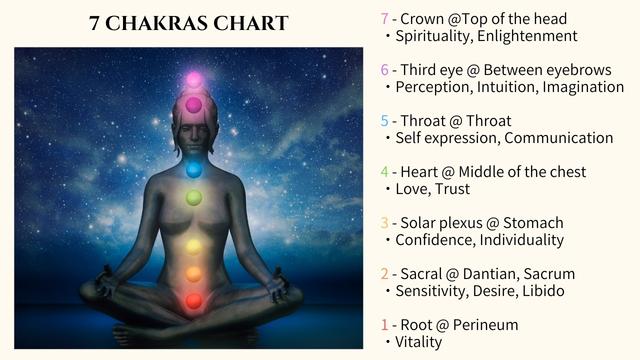
After releasing both feet and hands, we will release chakras in order from the bottom, so first breathe as if you are blowing air into the perineum which is the first chakra.
It's in between the genitals and the anus.
When you feel that the capillaries around here have opened and become warm, the next step is to open Dantian in the lower abdomen (below the navel) of the second chakra.
Next is near the stomach and epigastrium of the 3rd chakra → the heart (chest) of the 4th chakra → the throat of the 5th chakra → the pineal gland in the back of the eyebrows of the 6th chakra (you can feel the back of the nose) → the last with the top of the head open, and this chapter is over.
By now, I think it's been about 5 to 10 minutes.
Point
- Use 4-3-8 breathing method to release tension in each part of the body. *Image of opening capillaries
- Left foot → right foot → left hand → right hand → from the 1st chakra to the 7th chakra in order
At this point, no, I think most people have fallen asleep before coming here.
If I try to meditate before going to bed, I will fall asleep with high probability.
But I'm happy with that.
I think you often fall asleep on the way.
Don't think negatively like "Ah, I failed in meditation..."
You've been able to relax and sleep well, so always think positively that it's a good thing.
If you fall asleep by all means, I will tell you the "Tips for not falling asleep" at the end, so please wait a little longer.
6. Focus on your breathing and wait to enter the meditative state
After releasing each part of the whole body in 5, all you have to do is concentrate on breathing and wait for the meditative state.
At this time, you don't have to be conscious of breathing up to 8 and slowly exhaling like before.
It is good to repeat nasal breathing as it is, with a natural feeling.
You can also throw away the consciousness of storing air in your chest.
Only one, let's focus on some chakras and breathe.
My recommendation is still Dantian, but this is not absolute condition because it has tastes and compatibility.
However, if you aim at the upper chakras such as the pineal gland and the crown from the beginning, it is likely that you will be distracted and it will be difficult to concentrate on breathing, so it is safe to go around Dantian or below the chest. I feel that it is easier to get into the meditative state if you aim at the chakras.
At this time, various thoughts and feelings will come to your mind, but let's accept those thoughts rather than "Let's go to nothing, Let's go to nothing."
It's better also just observing thoughts and feelings.
In that process, thoughts disappear naturally as flowing, so we concentrate on breathing again, and when emotions are born, we naturally accept, parry, and concentrate on breathing again.
Then, one day the time to put yourself in meditation will be come.
The estimated time is completely different depending on individual differences and physical condition at that time, so it cannot be said clearly.
In my case, it takes about 5 minutes to get into meditation after entering this phase, and sometimes it takes about 30 minutes.
When I'm not feeling well, sometimes I can't go deep even if I take an hour, so I give up gracefully in such cases.
Even if you meditate while feeling too stubborn and painful, you will defeat the purpose, so if you try it for about 30 minutes and it still doesn't work, you can meditate without stress by trying again the next time you are in good condition.
Anyway, let's meditate comfortably and happily.
Point
Concentrate on one chakra, breathe repeatedly, and wait to get into the meditative state.
How do you feel when you get into deep meditation?

I'm going to explain what it feels like when you actually get into deep meditation state.
As I mentioned at the beginning, the meditation state is in theta wave state which is very like consciousness, drowsiness, hypnagogia, and REM sleep. The state in which the body is completely rested, but the brain is awake.
There are individual differences in the sensation that the brain wave feels when it enters theta wave, which is a meditative state, but it seems that everyone has the same sensation also.
In my case, as I repeat the breathing exercises I mentioned above, the first sensation is that my brain suddenly shrinks. It's just a tiny sensation, but it feels like the brain is atrophied about 5mm to 1cm.
After that, white and various colors of light start to swirl behind the closed eyelids. This sensation of light should be immediately apparent when you actually experience it.
At the same time, the limbs are completely weakened and the body cannot be easily moved. If I really want to move it, I can move it, but the feeling is that my body is stuck to the bed and that I have sleep paralysis.
As I have said several times, it is exactly the state in which the body is completely rested but the brain is awake.
If you feel like this, you too will be in the "Welcome to the meditation world."
When you get into this state for the first time, you will feel a very strange feeling. As an aside, in this state, I get the feeling that it sticks directly into my brain and heart if I hear the sound that emits a good frequency such as singing balls, healing music, and the sutra because there is no extra barrier. It's a sensation that even the vibration of the sound is transmitted realistically. I don't know if this is a trance state, but those who rely on drugs should master meditation.
The story went a little differently, but I hope you could understand the feeling when you were in meditation. It's a feeling that you can grasp it immediately once you actually experience it, so please try meditation happily aiming for this state.
The Tricks To Get Into Deep Meditation Without Falling Asleep
Here, I would like to teach little tricks to you who fall asleep immediately when you try meditation before going to bed.
Trick 1. Meditate in the daytime
Daytime meditation is perfect for holidays.
You're definitely less likely to fall asleep than before you go to bed at night.
It feels good to be able to meditate in an environment where the sun shines a little in the room on a sunny day.
Trick 2. Meditate in the middle of the night when you woke up to go to the bathroom
This is the one I do quite a bit.
Do not think "had enough," but let's think "OK, it's a chance" and meditate, when you woke up in the middle of the night.
It's easy to get into meditation because your body is quite relaxed.
If the next day is a holiday, don't hesitate to try it!
Trick 3. Wake up and meditate 2 hours before waking up in the morning
This is also easy to meditate because the physical condition is the same as Trick 2.
After getting enough sleep, you will feel less drowsy than Trick 2.
You should get enough sleep about 5 hours.
The alarm clock can be set 1 hour before, but if I fail, I can sleep a little again, so I often set the alarm clock about 2 hours before.
Tricks 4. Drink coffee before meditation (take caffeine)
It may seem a bit wicked, but it works pretty well.
Coffee, tea or herbal teas are fine, but taking caffeine before meditation will wake you up, clear your brain and give you good inspiration.
Especially in Trick 2 and Trick 3, if you take caffeine after sleeping and waking up, the brain will be awake 20 to 30 minutes after the start of meditation, so there is a high probability that you will not fall asleep and get into the meditation state.
I heard that the monks were meditating by drinking tea to keep them awake, so it may be the royal road.
-----
If you do these tricks on a day off or the day before the day off, I don't think there will be much damage, so try more and more while searching for a method that suits you.
What You Can Do After Meditation
When you get into the meditative state, the extra power is released and the brain is cleared, so your imagination expands tremendously. And there are so many things you can do after that, for example, you can open the chakras one by one, you can awaken the kundalini, you can see lucid dreaming, and you can even experience out-of-body. "Is it an occult!" you might think, but it's true because I say whom is in the opposite of the occult.
I have had lucid dreams from an early age, but I have succeeded in creating lucid dreams through meditation and getting into them several times. Like the world of Inception.
I have already experienced the rise of Kundalini, but when it comes to this story, it suddenly becomes suspicious, so only those who are interested should take a look my next article.
I have tried out-of-body several times, but it's quite difficult and I haven't succeeded yet. I mean, I'm pretty tired, so I'm not even trying now. However, the feeling of being able to leave the body is definitely understandable.
As anyone who has experienced meditation many times knows, they will be able to understand various spiritual phenomena such as ch'i, chakras, souls, telepathy, out-of-body, and psychic phenomena, even if they cannot actually manipulate them.
After all, it is an event in the conscious world, so I think that it will be possible to understand such high-dimensional phenomena, or at least it cannot be denied. That alone will surely broaden your horizons and change the way you look of the world and the universe.
So, after all, I believe you will think meditation is quit good.
Notes on meditation!
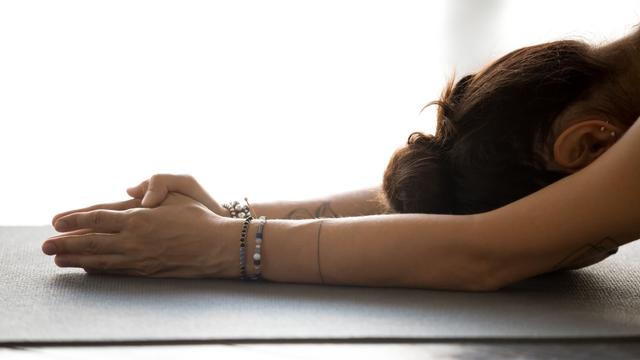
This may actually be the point I want to convey the most.
When you meditate and put yourself in a deep meditative state, you can certainly broaden your horizons, increase your imagination, have peace of mind, be surrounded by mysterious sensations, and have a spiritual experience. It is true that you have such an experience.
But!
Having such an experience does not mean that you have become a perfect human. I am convinced that anyone can experience it by training, even if the level is different depending on their sense. So, please do not misunderstand and run wild that, "I was enlightened!", "I was chosen by God!", "I understood the truth of the universe!"
The destination of such a person is the cult guru.
I affirm again, anyone can do it!
Through meditation, my goal is to calm my mind, remove anxiety, increase my vitality, and enrich the real world I live. And I want you to aim for that as well.
As a matter of fact, I don't spend much time for meditation right now. I only occasionally do it in the middle of the night or in the morning.
You might say, "Don't be fool now," but there's a good reason for this. Because I have a wife and a small son, it's more important to spend time with my family than to spend time meditating. There are tons of other fun things to do and things to prioritize, so for me it's a waste of time to spend on meditation.
To meditate, much less to master meditation, requires time alone and considerable training. There is even an anecdote that Bodhidharma, the founder of Zen Buddhism, became so addicted to meditation and meditated for nine years, resulting in his limbs rotten.
Please be careful not to escape from living in the real world and get too absorbed in the spiritual world and finally lose yourself. Even if I said so, meditation is still a great thing, so why not try a little to enrich the real world?
Finally,
I tried to explain in an easy-to-understand manner how to enter a deep meditation state by lying down meditation, but could you understand?
If you still can't get the hang of it, read it over and over again, add your own arrangements, and have fun trying to get into a good meditation.
I sincerely hope that you will not start a strange cult by immersing yourself in the spiritual world.
Wanna know my kundalini awakening experience? Well, maybe someday...
